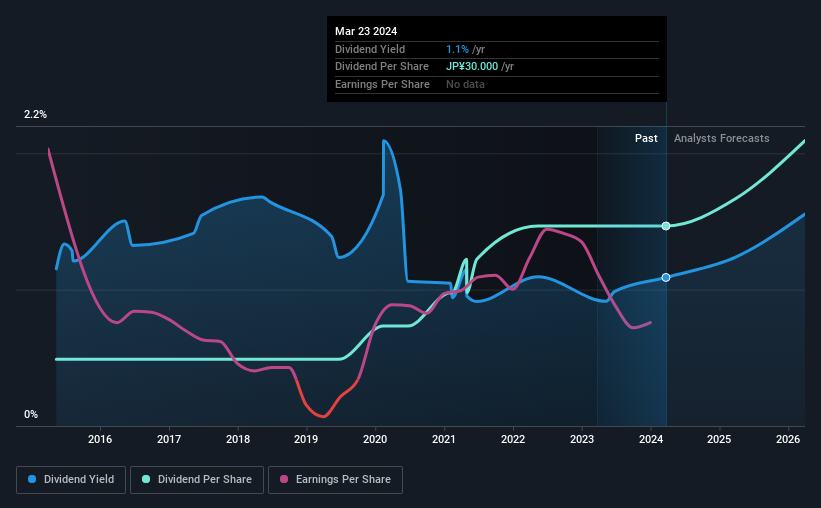Three Days Left Until Kadokawa Corporation (TSE:9468) Trades Ex-Dividend

Kadokawa Corporation (TSE:9468) is about to trade ex-dividend in the next three days. The ex-dividend date is one business day before a company's record date, which is the date on which the company determines which shareholders are entitled to receive a dividend. The ex-dividend date is important because any transaction on a stock needs to have been settled before the record date in order to be eligible for a dividend. Accordingly, Kadokawa investors that purchase the stock on or after the 28th of March will not receive the dividend, which will be paid on the 24th of June.
The company's next dividend payment will be JP¥30.00 per share, and in the last 12 months, the company paid a total of JP¥30.00 per share. Based on the last year's worth of payments, Kadokawa has a trailing yield of 1.1% on the current stock price of JP¥2754.00. We love seeing companies pay a dividend, but it's also important to be sure that laying the golden eggs isn't going to kill our golden goose! So we need to investigate whether Kadokawa can afford its dividend, and if the dividend could grow.
View our latest analysis for Kadokawa
If a company pays out more in dividends than it earned, then the dividend might become unsustainable - hardly an ideal situation. Kadokawa paid out more than half (60%) of its earnings last year, which is a regular payout ratio for most companies. A useful secondary check can be to evaluate whether Kadokawa generated enough free cash flow to afford its dividend. Over the past year it paid out 138% of its free cash flow as dividends, which is uncomfortably high. We're curious about why the company paid out more cash than it generated last year, since this can be one of the early signs that a dividend may be unsustainable.
Kadokawa does have a large net cash position on the balance sheet, which could fund large dividends for a time, if the company so chose. Still, smart investors know that it is better to assess dividends relative to the cash and profit generated by the business. Paying dividends out of cash on the balance sheet is not long-term sustainable.
While Kadokawa's dividends were covered by the company's reported profits, cash is somewhat more important, so it's not great to see that the company didn't generate enough cash to pay its dividend. Were this to happen repeatedly, this would be a risk to Kadokawa's ability to maintain its dividend.
Click here to see the company's payout ratio, plus analyst estimates of its future dividends.

Have Earnings And Dividends Been Growing?
Businesses with strong growth prospects usually make the best dividend payers, because it's easier to grow dividends when earnings per share are improving. Investors love dividends, so if earnings fall and the dividend is reduced, expect a stock to be sold off heavily at the same time. That's why it's comforting to see Kadokawa's earnings have been skyrocketing, up 46% per annum for the past five years. Earnings have been growing quickly, but we're concerned dividend payments consumed most of the company's cash flow over the past year.
The main way most investors will assess a company's dividend prospects is by checking the historical rate of dividend growth. Kadokawa has delivered 13% dividend growth per year on average over the past nine years. It's exciting to see that both earnings and dividends per share have grown rapidly over the past few years.
To Sum It Up
Is Kadokawa an attractive dividend stock, or better left on the shelf? The best dividend stocks typically boast a long history of growing earnings per share (EPS) via a combination of earnings growth and buybacks. That's why we're glad to see Kadokawa growing its EPS, buying back stock and paying out a reasonable percentage of its earnings as dividends. However, we note with some concern that it paid out 138% of its free cash flow last year, which is uncomfortably high and makes us wonder why the company chose to spend even more cash on buybacks. Overall we're not hugely bearish on the stock, but there are likely better dividend investments out there.
If you want to look further into Kadokawa, it's worth knowing the risks this business faces. Case in point: We've spotted 2 warning signs for Kadokawa you should be aware of.
Generally, we wouldn't recommend just buying the first dividend stock you see. Here's a curated list of interesting stocks that are strong dividend payers.
Valuation is complex, but we're here to simplify it.
Discover if Kadokawa might be undervalued or overvalued with our detailed analysis, featuring fair value estimates, potential risks, dividends, insider trades, and its financial condition.
Access Free AnalysisHave feedback on this article? Concerned about the content? Get in touch with us directly. Alternatively, email editorial-team (at) simplywallst.com.
This article by Simply Wall St is general in nature. We provide commentary based on historical data and analyst forecasts only using an unbiased methodology and our articles are not intended to be financial advice. It does not constitute a recommendation to buy or sell any stock, and does not take account of your objectives, or your financial situation. We aim to bring you long-term focused analysis driven by fundamental data. Note that our analysis may not factor in the latest price-sensitive company announcements or qualitative material. Simply Wall St has no position in any stocks mentioned.
About TSE:9468
Flawless balance sheet with solid track record.


